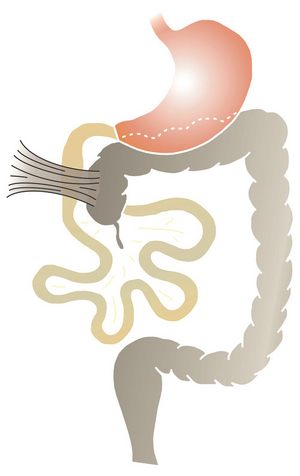Duodenal obstruction
From WikiLectures
- It belongs to the so-called proximal intestinal obstructions - these are characterized by - minor distension of the abdomen and permanent explosive vomiting.
 Ladd's Syndrome - unrotated cecum and duodenal compression by peritoneal bands.
Ladd's Syndrome - unrotated cecum and duodenal compression by peritoneal bands. - In the case of intestinal obstruction below the level of 15 cm from the beginning of the jejunum - the so-called distal obstruction - bloating, distension of the abdomen dominates, vomiting comes later.
- Obstruction of the duodenum can be caused by atresia (more often) or stenosis.
- It is more common in Down syndrome and in immature children.
- The obstruction is usually located below the major papilla of the duodenum.
- Otherwise, obstruction can also occur with incomplete rotation of the intestine, volvulus congenitalis, with pancreas annulare.
- Clinical picture:
- Obstruction of the duodenum is closely related to the circulation of amniotic fluid - in all cases of obstruction, polyhydramnios is detected during childbirth .
- Therefore, every time polyhydramnios is found, we have to aspirate the stomach contents with a tube after birth - and if it is more than 15 ml, we suspect proximal intestinal obstruction.
- The main symptom – projectile vomiting (with atresia it starts immediately after birth, with stenosis after several hours).
- Vomit is a yellowish admixture of bile.
- Sometimes we see a peristaltic wave similar to that of pylorostenosis.
- Distention - only in the epigastrium or absent.
- Laboratory – hypochloremic alkalosis, Na + and K + depletion;
- Diagnosis - ultrasound can be detected already intrauterine.
- After birth, the best native x-ray image of the abdomen in the hanging position (the contrast material is air swallowed by the baby) at the time of birth.
- Normally - immediately after birth, there should be air in the stomach, within 1 hour in the small intestine, in 4-18 hours in the large intestine.
- With atresia, the typical picture is of "two bubbles" - one in the stomach area, the other smaller one in the duodenum area.
- After birth, the best native x-ray image of the abdomen in the hanging position (the contrast material is air swallowed by the baby) at the time of birth.
- Therapy – surgical – duodenoplasty, duodenojejunostomy,
- prior to the operation, modification of the internal environment is necessary.
Links[edit | edit source]
Related Articles[edit | edit source]
Source[edit | edit source]
- BENEŠ, Jiří. Studijní materiály [online]. ©2007. [cit. 2010-04]. <http://www.jirben.wz.cz/>.
Bibliography[edit | edit source]
- HRODEK, Otto – VAVŘINEC, Jan, et al. Pediatrie. 1. edition. Praha : Galén, 2002. ISBN 80-7262-178-5.
- ŠAŠINKA, Miroslav – ŠAGÁT, Tibor – KOVÁCS, László, et al. Pediatria. 2. edition. Herba, 2007. ISBN 978-80-89171-49-1.
